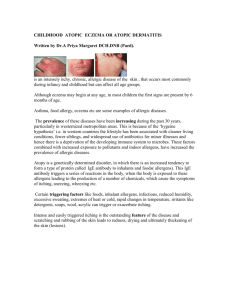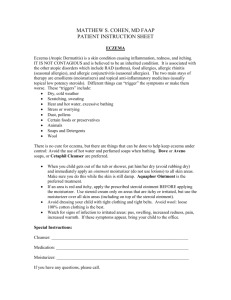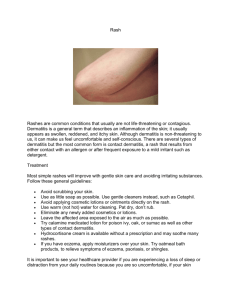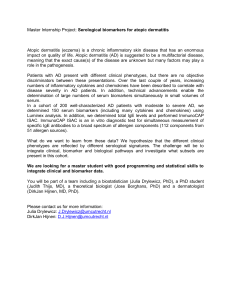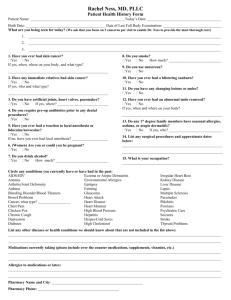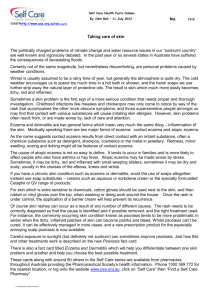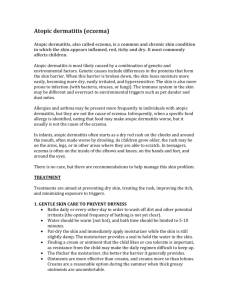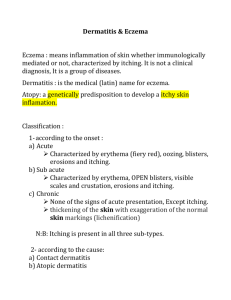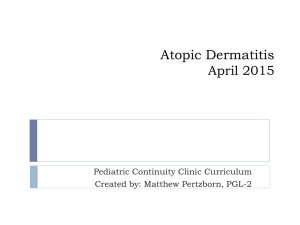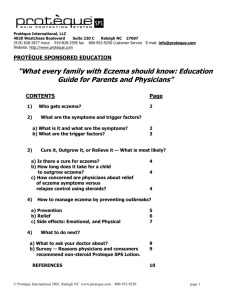ECZEMA (DERMATITIS)
advertisement
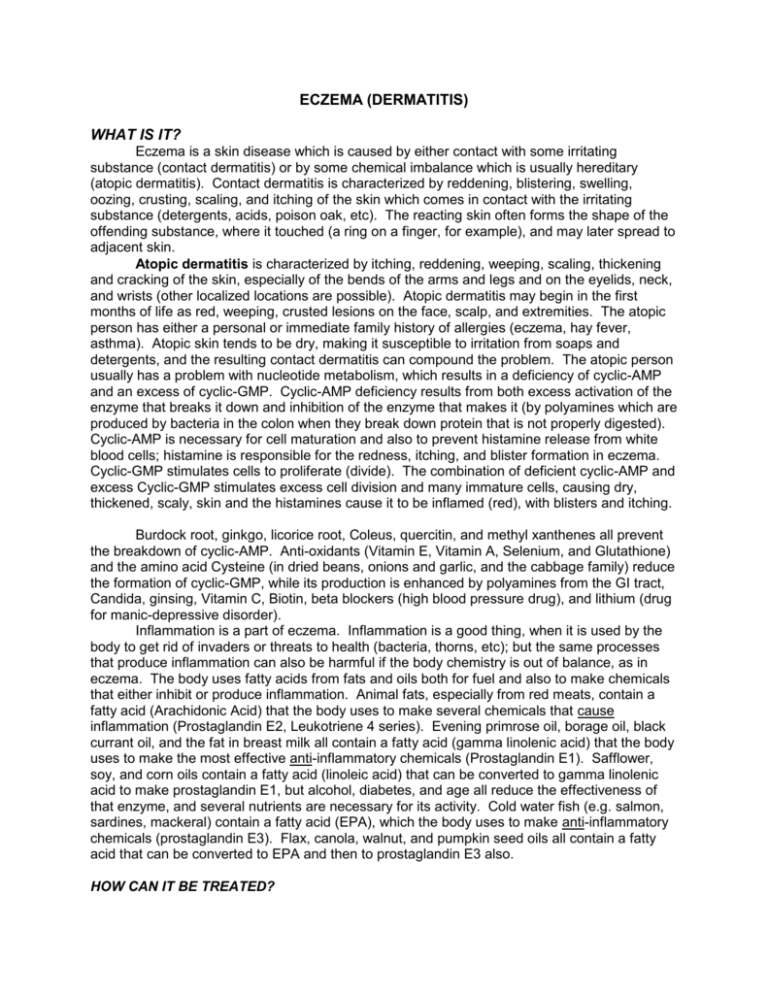
ECZEMA (DERMATITIS) WHAT IS IT? Eczema is a skin disease which is caused by either contact with some irritating substance (contact dermatitis) or by some chemical imbalance which is usually hereditary (atopic dermatitis). Contact dermatitis is characterized by reddening, blistering, swelling, oozing, crusting, scaling, and itching of the skin which comes in contact with the irritating substance (detergents, acids, poison oak, etc). The reacting skin often forms the shape of the offending substance, where it touched (a ring on a finger, for example), and may later spread to adjacent skin. Atopic dermatitis is characterized by itching, reddening, weeping, scaling, thickening and cracking of the skin, especially of the bends of the arms and legs and on the eyelids, neck, and wrists (other localized locations are possible). Atopic dermatitis may begin in the first months of life as red, weeping, crusted lesions on the face, scalp, and extremities. The atopic person has either a personal or immediate family history of allergies (eczema, hay fever, asthma). Atopic skin tends to be dry, making it susceptible to irritation from soaps and detergents, and the resulting contact dermatitis can compound the problem. The atopic person usually has a problem with nucleotide metabolism, which results in a deficiency of cyclic-AMP and an excess of cyclic-GMP. Cyclic-AMP deficiency results from both excess activation of the enzyme that breaks it down and inhibition of the enzyme that makes it (by polyamines which are produced by bacteria in the colon when they break down protein that is not properly digested). Cyclic-AMP is necessary for cell maturation and also to prevent histamine release from white blood cells; histamine is responsible for the redness, itching, and blister formation in eczema. Cyclic-GMP stimulates cells to proliferate (divide). The combination of deficient cyclic-AMP and excess Cyclic-GMP stimulates excess cell division and many immature cells, causing dry, thickened, scaly, skin and the histamines cause it to be inflamed (red), with blisters and itching. Burdock root, ginkgo, licorice root, Coleus, quercitin, and methyl xanthenes all prevent the breakdown of cyclic-AMP. Anti-oxidants (Vitamin E, Vitamin A, Selenium, and Glutathione) and the amino acid Cysteine (in dried beans, onions and garlic, and the cabbage family) reduce the formation of cyclic-GMP, while its production is enhanced by polyamines from the GI tract, Candida, ginsing, Vitamin C, Biotin, beta blockers (high blood pressure drug), and lithium (drug for manic-depressive disorder). Inflammation is a part of eczema. Inflammation is a good thing, when it is used by the body to get rid of invaders or threats to health (bacteria, thorns, etc); but the same processes that produce inflammation can also be harmful if the body chemistry is out of balance, as in eczema. The body uses fatty acids from fats and oils both for fuel and also to make chemicals that either inhibit or produce inflammation. Animal fats, especially from red meats, contain a fatty acid (Arachidonic Acid) that the body uses to make several chemicals that cause inflammation (Prostaglandin E2, Leukotriene 4 series). Evening primrose oil, borage oil, black currant oil, and the fat in breast milk all contain a fatty acid (gamma linolenic acid) that the body uses to make the most effective anti-inflammatory chemicals (Prostaglandin E1). Safflower, soy, and corn oils contain a fatty acid (linoleic acid) that can be converted to gamma linolenic acid to make prostaglandin E1, but alcohol, diabetes, and age all reduce the effectiveness of that enzyme, and several nutrients are necessary for its activity. Cold water fish (e.g. salmon, sardines, mackeral) contain a fatty acid (EPA), which the body uses to make anti-inflammatory chemicals (prostaglandin E3). Flax, canola, walnut, and pumpkin seed oils all contain a fatty acid that can be converted to EPA and then to prostaglandin E3 also. HOW CAN IT BE TREATED? 1. Improve hydration of the skin (moisture in the skin): a. Avoid soap (too drying). Oil products can be used for cleansing. b. Drink 2-3 quarts (64-96 oz.) of water daily. c. Take a tepid bath (in between cool and warm), for 20-30 min. 1 to 3 times a day. 1) oil bath - use mineral oil or any good cold-pressed, non-rancid oil 2) starch bath - 1/2 box Argo or 1 cup Aveena to reduce itch and soothe d. Apply an oil, cream, or ointment while still wet. 2. Protect skin from irritants a. Avoid perfumes, "caine" lotions, wool or rough fabrics, and extremes of temperature. b. Use vinyl (better than rubber) gloves with a washable cotton or disposable liner when cleaning or coming in contact with chemicals. Avoid using for more than 1 hour at a time. c. Use gripping tools instead of hands whenever possible when working with irritants. 3. Prevent skin infection a. Proper hygiene. b. Good nutrition, immune system enhancement. c. Monitor for pus, swollen glands, fever. 4. Good nourishment a. Consider food sensitivities; do food sensitivity testing or a hypoallergenic diet b. Supplements 1) Betaine Hydrochloride - to improve protein digestion and prevent polyamine production to improve cell maturation 2) EPO (Evening Primrose Oil)/ Borage Oil/ Black Currant Oil/ Flax oil - to make antiinflammatory chemicals 3) Vitamin A - to improve cell maturation and reduce cell proliferation 4) Vitamin E - to reduce cell proliferation and speed healing 5) Zinc picolinate - to speed healing 6) Bioflavenoids, Quercitin - to improve cell maturation (prevent breakdown of cyclicAMP) c. Diet 1) Restrict intake of animal fats, especially from red meat (butterfat is fine) - to prevent production of inflammatory chemicals from Arachidonic Acid 2) Eat cold water fish (salmon, sardines, mackerel, tuna), nuts and seeds, and coldpressed vegetable oils - to produce anti-inflammatory chemicals 5. Herbal support a. Ginkgo b. Burdock root c. Licorice root d. Zizufus jujuba e. Coleus forskolii 6. Homeopathy - to treat the underlying hereditary weakness and disease tendency. Be patient. It takes some time for the biochemistry to rebalance and for the skin to heal.

